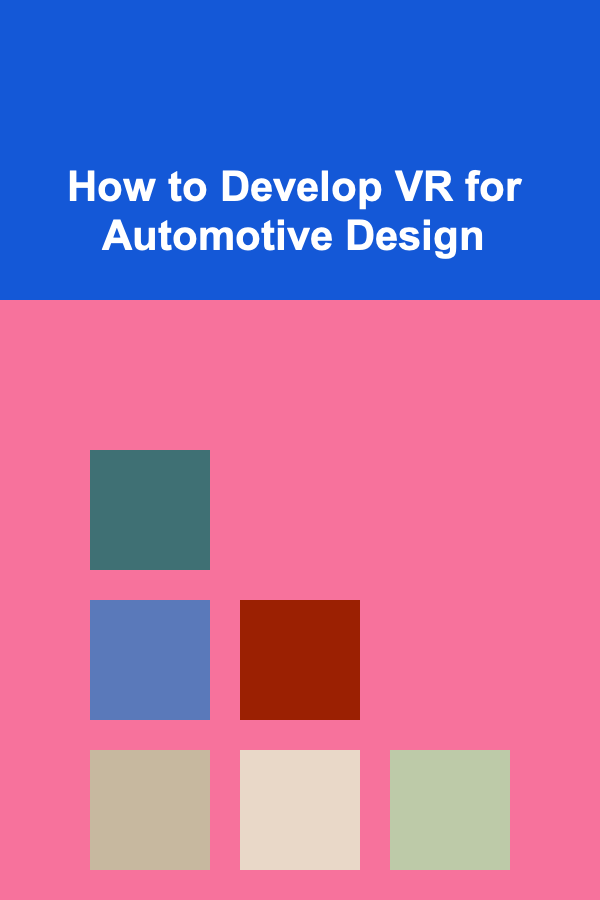
How to Develop VR for Automotive Design
ebook include PDF & Audio bundle (Micro Guide)
$12.99$7.99
Limited Time Offer! Order within the next:

Virtual Reality (VR) technology has become an essential tool in various industries, revolutionizing the way design, development, and testing are approached. In the automotive industry, VR is increasingly being leveraged to create more efficient and innovative automotive designs. From concept development to manufacturing, VR enhances the entire process by offering immersive simulations, faster prototyping, and real-time collaboration among designers and engineers. This article will guide you through the process of developing VR for automotive design, examining the tools, methodologies, challenges, and benefits of this transformative technology.
The Role of VR in Automotive Design
In the automotive industry, designing a vehicle is a highly complex process. Traditional methods of design, such as physical prototypes and 3D renderings, require significant time and financial resources. VR offers the ability to create immersive, interactive simulations of vehicle designs that can be tested, modified, and refined in real-time. VR can be utilized at every stage of automotive design, from early conceptualization to final validation, and can provide several key benefits:
- Enhanced Visualization: VR allows designers to experience and evaluate a car's design from multiple perspectives, whether it's the exterior, interior, or components that may be difficult to visualize in traditional methods.
- Real-Time Feedback and Collaboration: Designers, engineers, and stakeholders can meet in a virtual environment, making collaborative decisions that can significantly reduce the development time.
- Cost Savings: By reducing the need for physical prototypes, VR helps in lowering costs associated with materials, labor, and manufacturing.
- Improved Ergonomics and Usability: Designers can walk around, sit inside, and interact with their designs in VR, making it easier to test for comfort and usability, ultimately improving the final product.
Steps to Develop VR for Automotive Design
1. Define the Project Scope and Requirements
Before diving into the technical aspects of VR development, it's crucial to define the project scope and requirements clearly. The automotive design process encompasses many stages, from initial sketches to full-scale prototypes. Determining what part of the design process VR will be integrated into is the first step.
Some questions to ask during the initial phase include:
- What aspect of the automotive design will be explored in VR? Are you focusing on interior design, exterior design, or engineering simulations?
- What is the target audience for the VR experience? Will it be for designers, engineers, stakeholders, or customers?
- What level of interaction and immersion is required? Will users need to interact with the design in real-time or merely view it?
Defining these requirements will help shape the technical tools and platforms that will be used throughout the development process.
2. Choose the Right VR Hardware
Selecting the appropriate VR hardware is critical for an effective automotive design VR experience. Several VR systems are available on the market, each with its strengths and weaknesses. Some of the most popular VR hardware for automotive design includes:
- HTC Vive: Known for its high precision and room-scale VR capabilities, the HTC Vive is often used in automotive design for its accurate tracking system and large play area.
- Oculus Rift: Oculus provides an affordable yet immersive experience suitable for automotive design teams, especially for virtual walkthroughs and early-stage designs.
- Valve Index: A high-end VR headset offering high refresh rates and excellent visual clarity, suitable for more detailed automotive simulations and virtual design reviews.
- Microsoft Hololens (Mixed Reality): While not strictly VR, mixed reality (MR) devices like the Hololens can be used for automotive design, especially when augmented reality (AR) elements are desired in the design process.
In addition to headsets, other hardware to consider includes motion tracking devices, haptic feedback controllers, and steering wheel simulators for more hands-on automotive testing. Hardware should be selected based on project requirements, performance needs, and budget constraints.
3. Develop 3D Models and Assets
To bring automotive designs into a virtual environment, 3D models of the vehicle components must be created. These models form the foundation of the VR experience and must be detailed and accurate to ensure the simulation feels realistic.
3D Modeling Tools:
- AutoCAD: A widely used tool for creating precise technical drawings and 3D models. It's an excellent choice for designing components like chassis and car frames.
- Blender: Open-source software that allows for the creation of detailed 3D models and animations, often used for visualizing the exterior and interior details of cars.
- SolidWorks: A CAD (computer-aided design) software that specializes in engineering designs. It's often used for automotive part modeling and simulations, especially in terms of mechanics and aerodynamics.
- Maya: This is another powerful 3D modeling tool, often used for more detailed and organic designs, including the interior cabin, seats, and dashboard.
The 3D models created in these tools should then be optimized for use in VR. This involves reducing polygon count, applying textures, and ensuring that assets can be loaded quickly in the VR environment without compromising performance.
4. Implement VR Development Frameworks
Once the 3D models are ready, the next step is to develop the VR environment itself. Several game engines and development frameworks are available to assist in VR development, each offering a different set of tools and capabilities.
- Unity: One of the most widely used game engines for VR development, Unity provides robust tools for 3D rendering, physics simulation, and multi-user interactions. Its large community support and asset store make it a go-to choice for automotive VR development.
- Unreal Engine: Known for its high-quality graphics, Unreal Engine is used to create photorealistic simulations in automotive VR. It offers excellent rendering capabilities and supports a range of VR devices.
- CryEngine: While less popular than Unity and Unreal Engine, CryEngine is still a viable choice for creating immersive and high-fidelity VR experiences, especially for environments that require detailed textures and simulations.
Developing VR for automotive design with these engines involves programming interactive elements such as object manipulation, environment navigation, and VR-specific features like head-tracking and controller inputs.
5. Integrate Real-Time Interactions and Physics Simulations
A key advantage of VR in automotive design is its ability to offer real-time interactions and simulations. Once the 3D models are imported into the chosen game engine, it's important to incorporate real-time physics simulations and interactive elements. These may include:
- Vehicle Dynamics: Simulate the vehicle's handling, aerodynamics, and suspension systems to allow designers to understand how the vehicle will perform on the road. Unity and Unreal Engine both offer built-in physics engines that can be integrated with automotive simulations.
- Interactive Elements: Allow users to interact with different components of the vehicle, such as opening doors, adjusting seats, or testing the functionality of the dashboard.
- Ergonomics and Human Factors: Ensure that the design is user-friendly by simulating human interaction with the vehicle, including seating comfort, visibility, and dashboard controls.
By integrating these features, developers can create an immersive and functional VR experience that accurately represents the final product.
6. Testing and Iteration
Once the VR experience is set up, thorough testing must be conducted to ensure that the system works as expected. This includes:
- Performance Testing: Ensure that the VR environment runs smoothly and efficiently on the chosen hardware, with minimal latency or lag.
- Usability Testing: Have users interact with the VR environment and provide feedback on ease of use, clarity, and intuitive design.
- Design Validation: Test different design iterations and gather feedback from designers, engineers, and other stakeholders to refine the design.
Iterating based on feedback is crucial, as the goal is to continuously improve the VR environment until it meets the project's objectives.
7. Deploy and Collaborate
Once the VR automotive design is validated, it's time to deploy it for use in collaborative settings. The VR environment can be used for design reviews, where teams can virtually walk through the design and provide feedback. VR also allows for remote collaboration, where designers and engineers can meet in a virtual environment regardless of their physical location.
Moreover, VR can be deployed to customers for design validation and market feedback, allowing manufacturers to present prototypes to a broader audience before committing to physical production.
Challenges in VR Automotive Design
While VR has immense potential in automotive design, there are several challenges that must be addressed:
- High Development Costs: The process of developing high-quality VR environments, creating detailed 3D models, and integrating simulations can be resource-intensive.
- Hardware Limitations: Not all VR hardware is suited for the detailed, high-performance simulations required in automotive design. Ensuring that the VR system works effectively across different devices is a challenge.
- Realism and Immersion: Achieving photorealistic graphics and physical simulations that mirror the real-world driving experience requires sophisticated rendering techniques and computational power.
Conclusion
Developing VR for automotive design is a multifaceted process that requires collaboration between designers, engineers, and developers. By leveraging VR technology, automotive manufacturers can streamline their design process, reduce costs, and enhance product quality. The key to success in VR development for automotive design lies in careful planning, choosing the right hardware and software tools, creating realistic simulations, and continuously testing and iterating on the design. As the automotive industry continues to embrace VR, it holds the potential to revolutionize how cars are conceived, developed, and experienced, ultimately leading to safer, more efficient, and innovative vehicles.

How to Create a Checklist for Designing Visual Content
Read More
How to Protect Your Home from Break-Ins While on Vacation
Read More
How to Renovate Your Home for a More Open and Airy Feel
Read More
How to Transform Your Bathroom with DIY Projects
Read More
How to Advocate for Protected Areas Expansion
Read More
Mastering Typography for Impact
Read MoreOther Products

How to Create a Checklist for Designing Visual Content
Read More
How to Protect Your Home from Break-Ins While on Vacation
Read More
How to Renovate Your Home for a More Open and Airy Feel
Read More
How to Transform Your Bathroom with DIY Projects
Read More
How to Advocate for Protected Areas Expansion
Read More